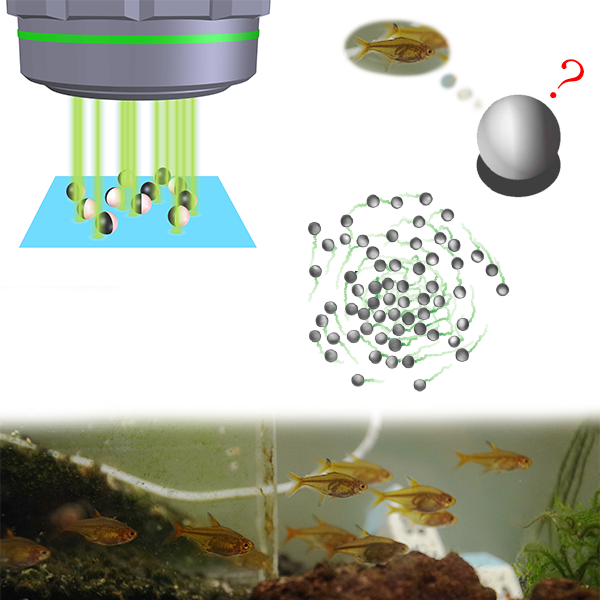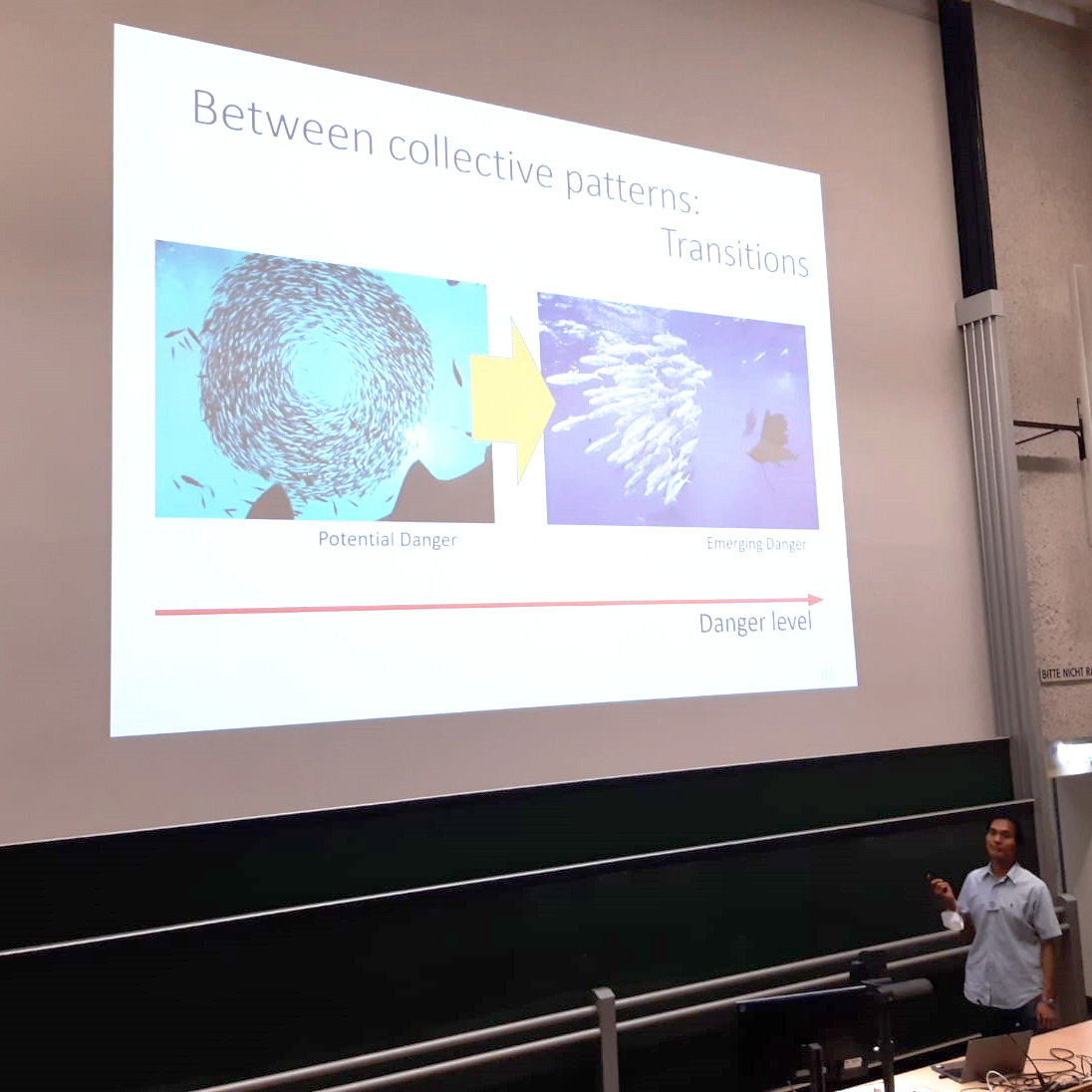
You can find out more detail about the presented work as the contents of this talk was based on Chun-Jen and Clemens Bechinger’s publication at New J. Phys. 24 033001 (2022).

You can find out more detail about the presented work as the contents of this talk was based on Chun-Jen and Clemens Bechinger’s publication at New J. Phys. 24 033001 (2022).
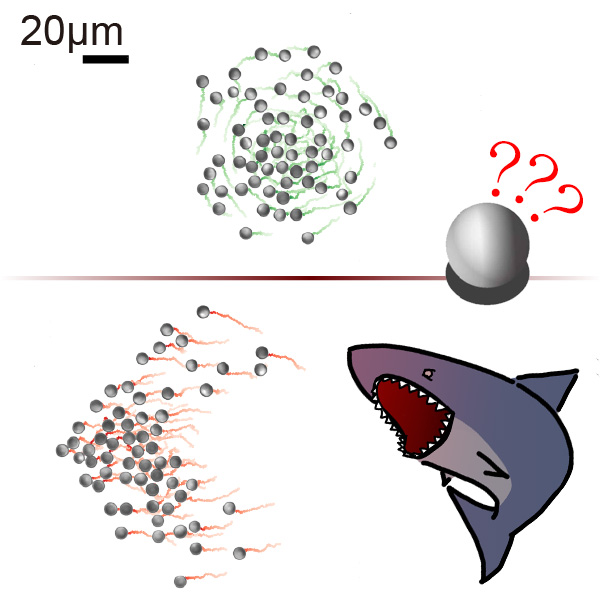
Chun-Jen Chen and Clemens Bechinger
New J. Phys. 24 033001 (2022)
doi: 10.1088/1367-2630/ac5374
repository: KOPS:56911
Many animal species organize within groups to achieve advantages compared to being isolated. Such advantages can be found e.g. in collective responses which are less prone to individual failures or noise and thus provide better group performance. Inspired by social animals, here we demonstrate with a swarm of microrobots made from programmable active colloidal particles (APs) that their escape from a hazardous area can originate from a cooperative group formation. As a consequence, the escape efficiency remains almost unchanged even when half of the APs are not responding to the threat. Our results not only confirm that incomplete or missing individual information in robotic swarms can be compensated by other group members but also suggest strategies to increase the responsiveness and fault-tolerance of robotic swarms when performing tasks in complex environments.
Press release at Universität Konstanz website:
How animal swarms respond to threats: With the help of microrobots, Konstanz physicists decode how swarms of animals respond effectively to danger [in English]
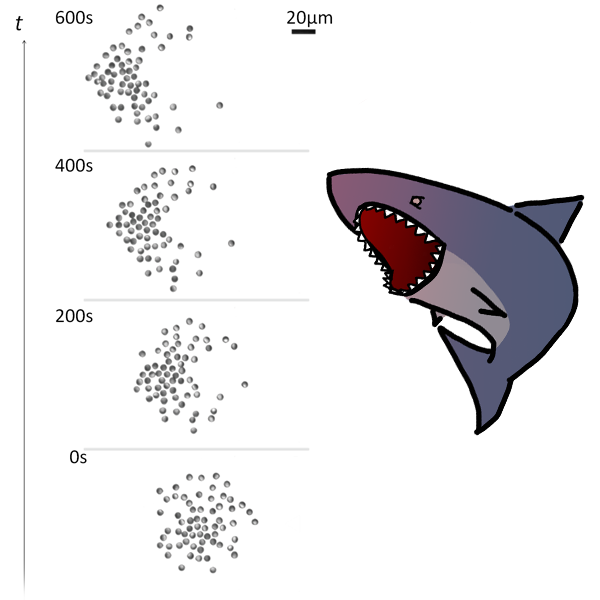

The school was focused on three main topics: Swimming into complex environment – micro-swimming, Collective motion, and Machine learning applied to active particles, and covered a wide range of models regarding chemical and biological microswimmers.
The school was organised in lecture sections and project sessions for participants to collaborate in groups, in which PhD students and post-doctoral researchers could develop a research project in one of the three main topics of the school. Chun-Jen was involved in a simulation project on a Vicsek-like model in complex environment which is still ongoing.
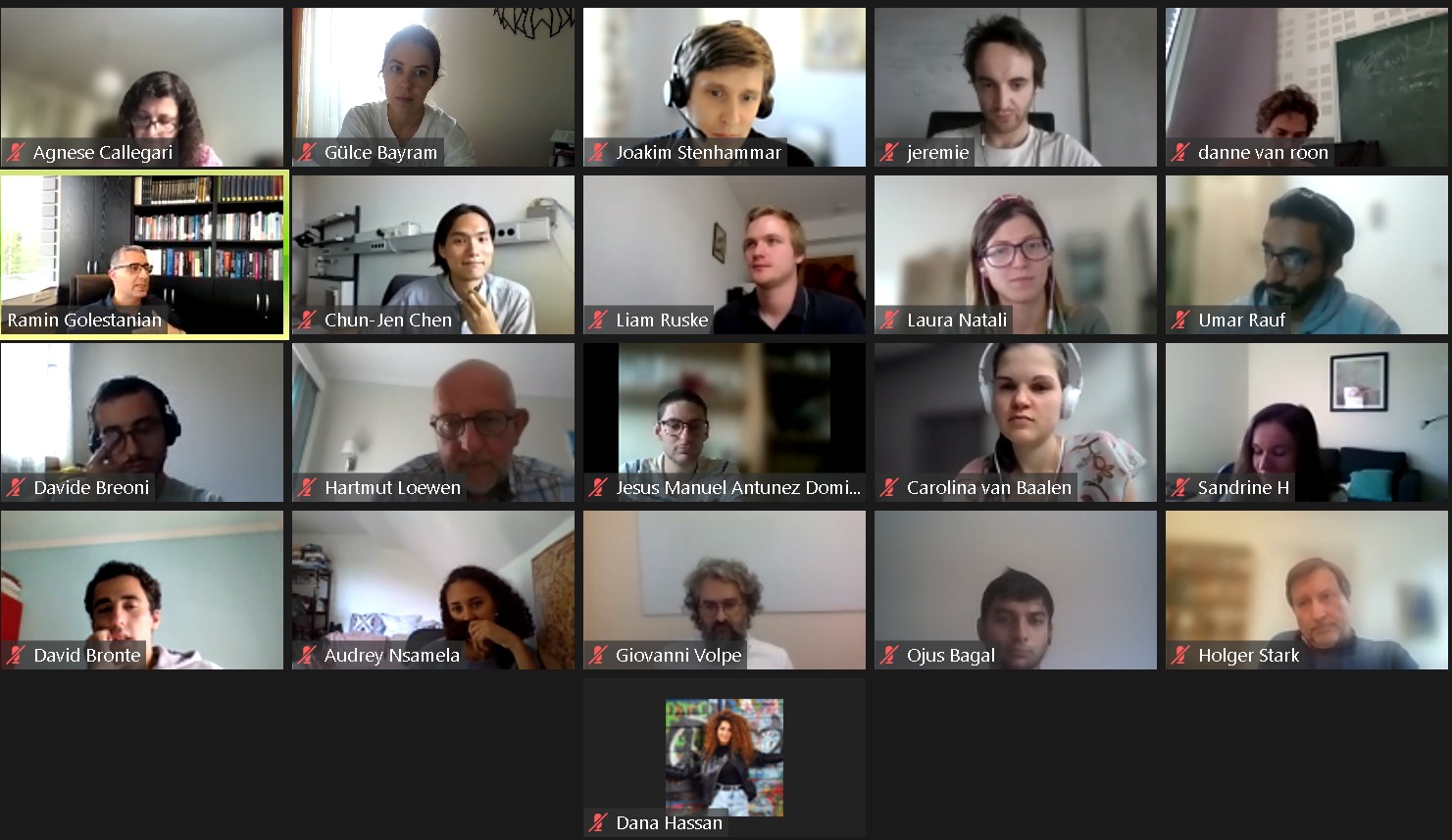
The fourth round table of the theoretical training took place with the participation of our panelists: Hartmut Löwen, Joakim Stenhammar, Holger Stark and Ramin Golestanian. The organizing ESRs were Ayten Gülce Bayram, Chun-Jen Chen, Jérémie Bertrand, Jesus Manuel Antunez Dominguez, Ojus Satish Bagal, Alireza Khoshzaban and Umar Rauf. The discussion mainly addressed to “Theoretical Models for Active matter”.
The discussion started with how the activity is included in theoretical models and how activity terms change depending on the particles system. It is followed by the theoretical aspects of going from one particle to the many-particle system and the relevant interaction terms in the theoretical models. Next, we mentioned the challenges behind the solvent-particle interaction, especially where we have complex solvents like a viscoelastic solvent. In this regard, our guests pointed out the importance of hydrodynamics. The meeting was concluded with the final remarks of our guests on the discussion that we should keep in mind in our future studies on active matter physics.

In our third round table we had the pleasure of Gareth Alexander, Ignacio Pagonabarraga and Julia Yeomans as our guest panellists. This time the overall theme was “Fluids and Active Matter” and hosted by Chun-Jen Chen, Davide Breoni, Danne van Roon, Audrey Nsamela, Dana Hassan and Sandrine Heijnen.
It started out with an interesting discussion regarding the motivation to get in and what amazes them the most in the field of active matter. Here it became clear that active systems can have their passive counterparts, and works for easy transitions from active to passive systems, but at the same time, such active systems still have the potential to answer many fundamental questions. From this topic, one of the key takeaways was that the project that you are currently working on should be the subject that amazes you the most.
The next topic that stood as the centre of the discussion was turbulence. Turbulence is an interesting phenomenon where a lot of things are still unknown. The intriguing concept here was that real, or fluid-dynamical, turbulence is different from active turbulence. As a clarification, Julia Yeomans introduced the following comparison. Real turbulence is observed in a waterfall where the energy follows the Kolmogorov cascade. In active turbulence, the energy originates from the individual particles moving and does not follow the same energy trend as real turbulence.
As one of the final topics, we were wondering what are the main takeaways regarding active nematics, especially if it’s not your field. We got it set for you in four points. One, it is fundamentally unstable and therefore creates flows. Point number two, motile topological effects. Number three, the potential connection it has to biological systems and the ability to explain similar processes. Finally, number four, the fact that we are looking at non-equilibrium systems.

 New ActiveMatter logos: color and BW version. (Image by ActiveMatter ESRs)
New ActiveMatter logos: color and BW version. (Image by ActiveMatter ESRs)
The last round table of this workshop regarded the topic advanced control of active matter. As organizers of round table, Audrey Nsamela, Chun-Jen Chen, Sandrine Heijnen, Harshith Bachimanchi and Alireza Khoshzaban, we welcomed and introduced our esteemed guests, namely Jérémie Palacci from University of San Diego, Clemens Bechinger from Konstanz University, Frank Cichos from Leipzig University, and Lucio Isa from ETH Zurich.
The round table started out with a clarification on advanced control of active matter. Active matter can be controlled by numerous external stimuli but implementing control on individual particles or artificial entities is what qualifies as advanced control. Currently, the control of active matter is still far from the behavior and control micro-organisms have on that scale; hence a big challenge lies there for us. Jérémie Palacci introduced an interesting research topic where they found a way to regulate the swimming process of E. Coli by light illumination. Here genetic modification was used to control the proton pump involved in the energy transportation process.
Advanced control of active matter can be applied to model systems where the control is lacking, for example biological systems. In a biological system the control over an organism is limited to the external stimuli that are applied and won’t always result in the same reaction. Therefore, using active particles showing predictable and reproducible behaviors when exposed to a stimulus works perfectly to model and to probe different parameters and thus provide a deeper understanding of the system. The fact advanced control of active matter doesn’t have an application outside of modelling systems is something we shouldn’t be ashamed of.
We concluded the meeting by asking every one of our guests what the promising research directions in the advanced control of active matter are. All of them had a different perspective. Starting with Clemens Bechinger, who was most invested in the further exploration of the applications for model systems. Lucio Isa is mainly looking forward to explore the different materials that we can use to create active material that can subsequently be controlled. Frank Cichos mentioned the importance of looking into new ways to create active particles. So far nature was able to achieve production of active entities with limited waste whereas human production is rather inefficient. Jérémie Palacci pointed out that the current man-made active matter systems are reacting to a strong signal in a well-controlled environment, where nature faces many more factors and still works. It would be interesting to design a system that is resistant to noise.
The third round table session of the experimental training was about machine learning and its role in science, in particular physics and active matter. The panelists invited to the discussion were Carlo Manzo from Vic University, Benjamin Midtvedt and Saga Helgadottir from Gothenburg University, Onofrio Maragò and Alessandro Magazzù from CNR ICPF-Messina. The discussion was organized and lead by Jesus M. A. Dominguez, Davide Breoni, Liam Ruske, Chun-Jen Chen and Alireza Khoshzaban, who are students attending the training.
The discussion touched topics like the applications of machine learning in fields like optics, biophysics, medical research, the potentialities and the reliability of the method. Questions on when a machine learning approach is advisable and how cautious one must be when applying machine learning were also addressed. Current important logical and practical aspects of the method were also discussed, together with the need of testing machine learning applications against more classical ones. The panelists also stated the importance of reliably checking the results obtained to avoid biases that can lead to false conclusions.
After one hour of fruitful discussion we gained a broader perspective and a deeper understanding of machine learning.
